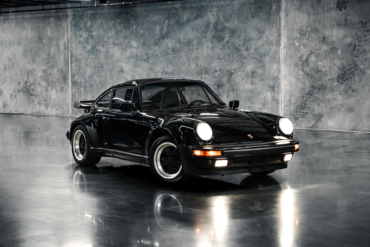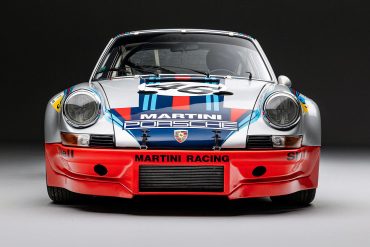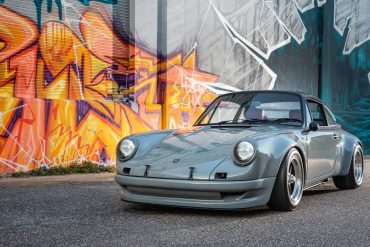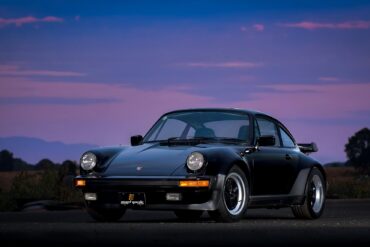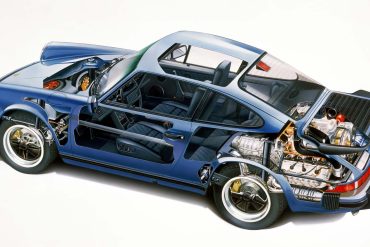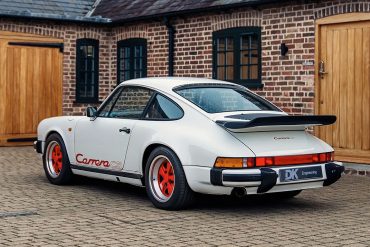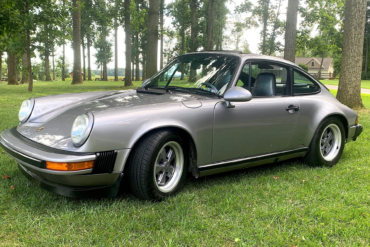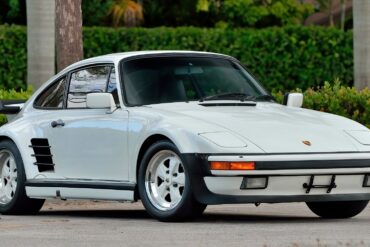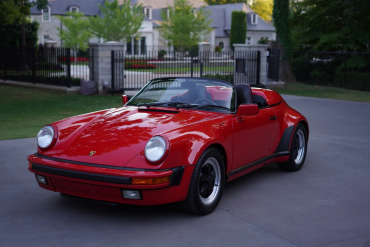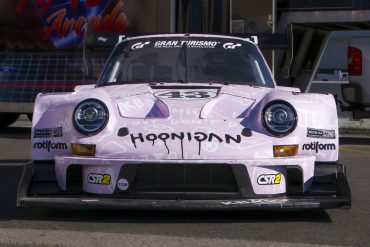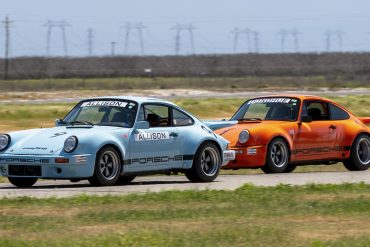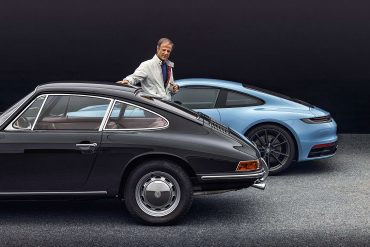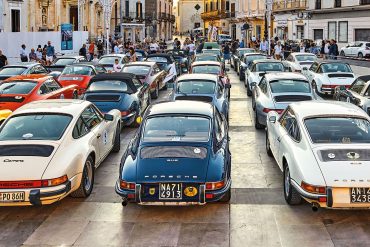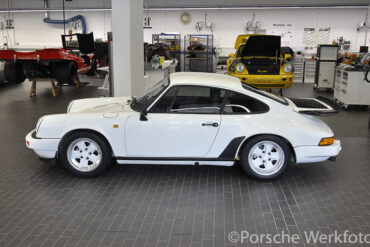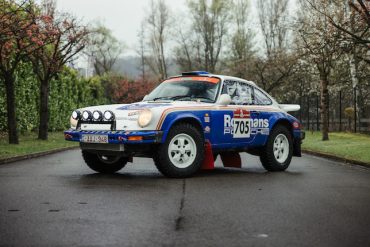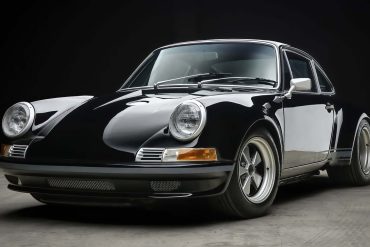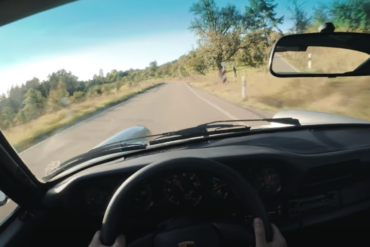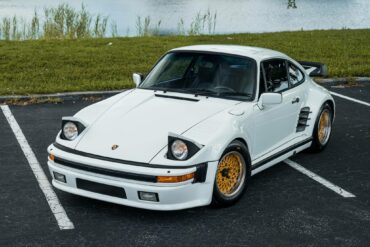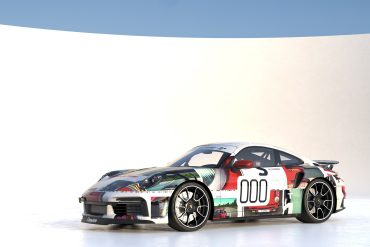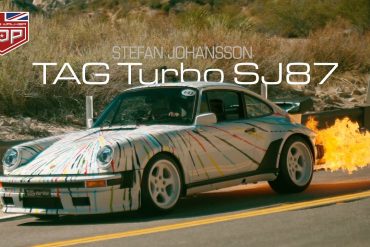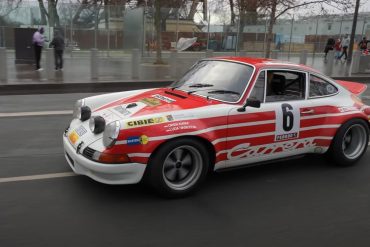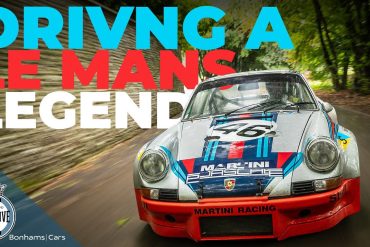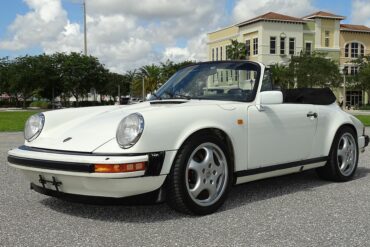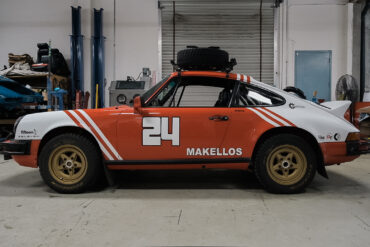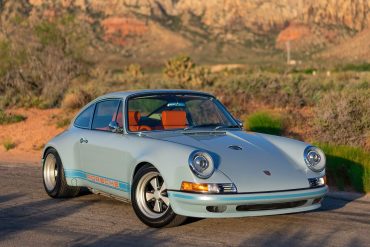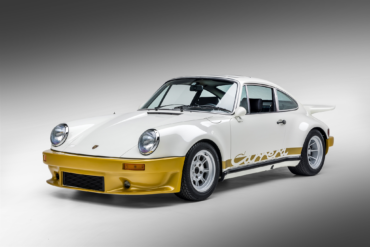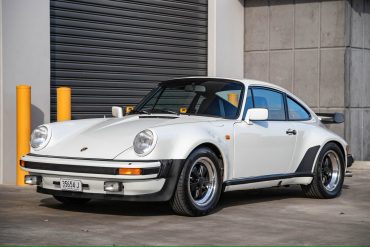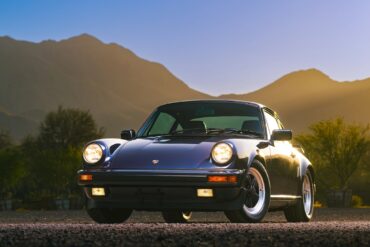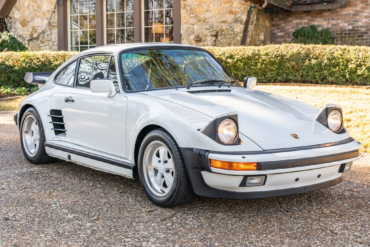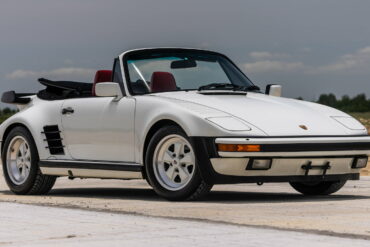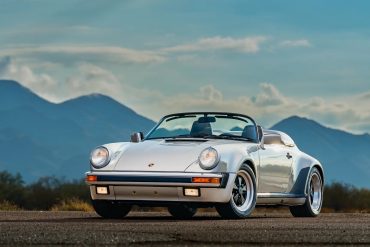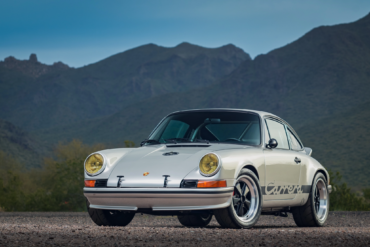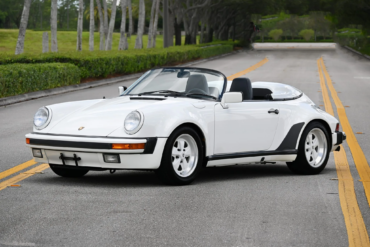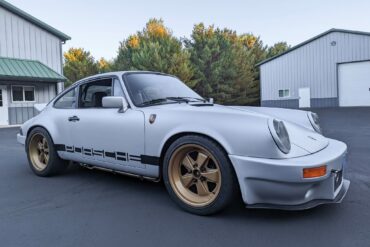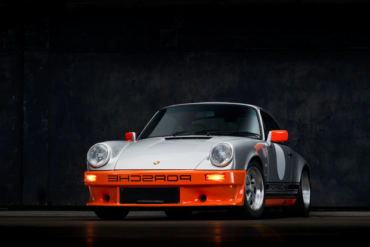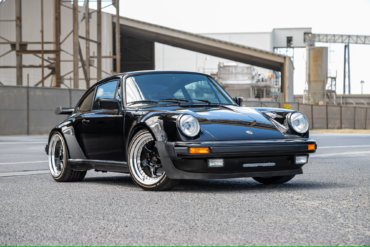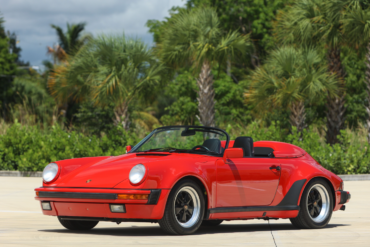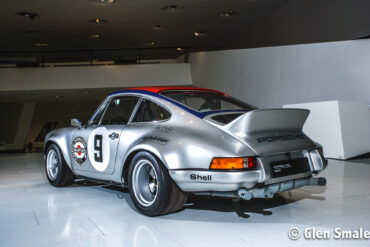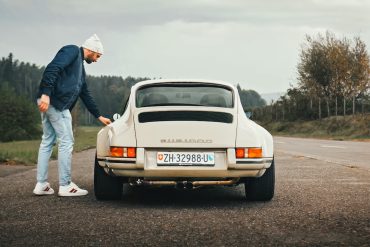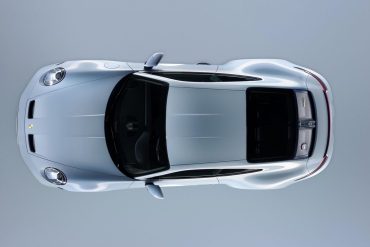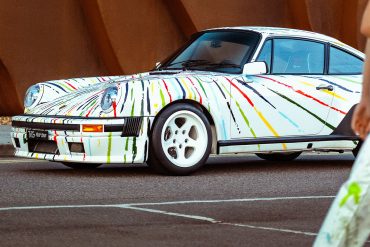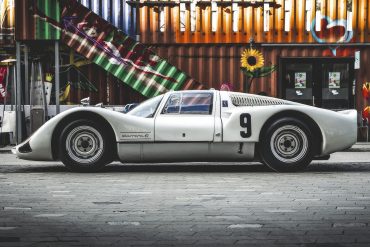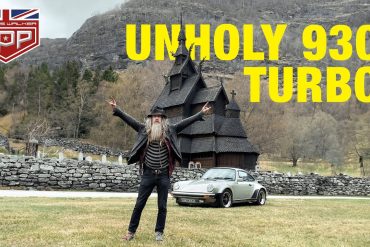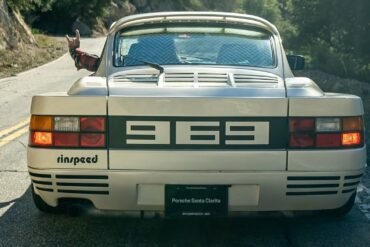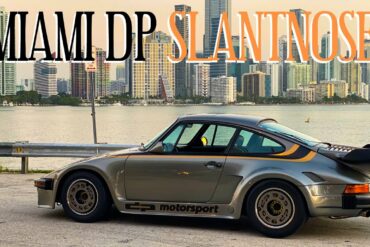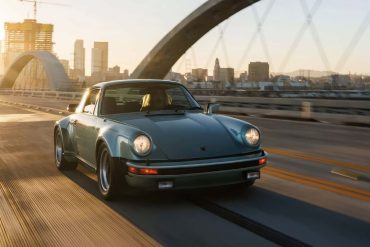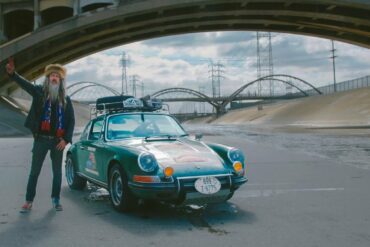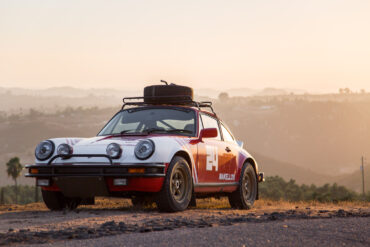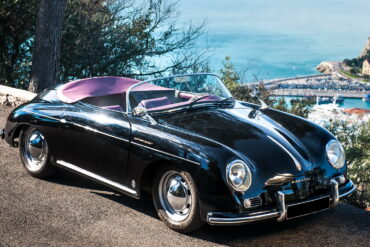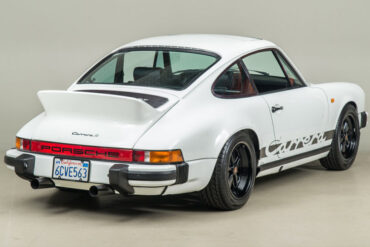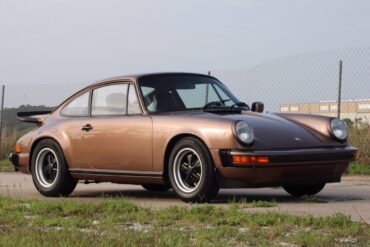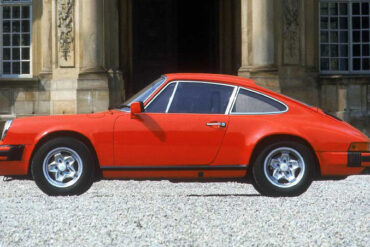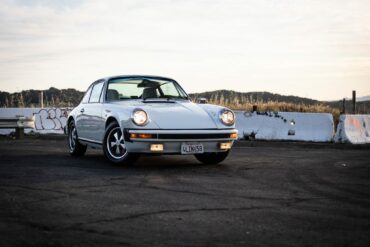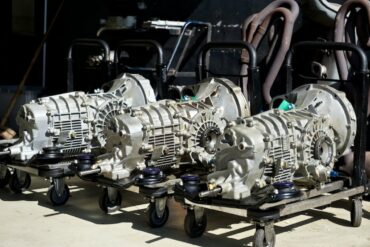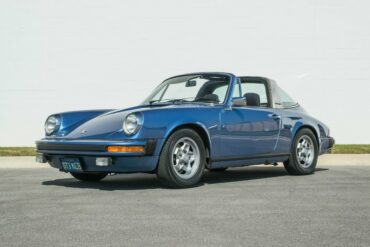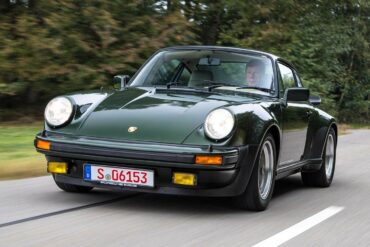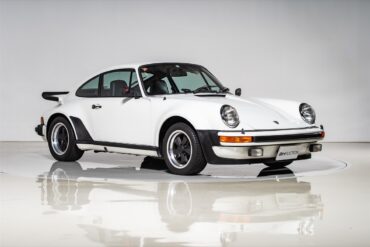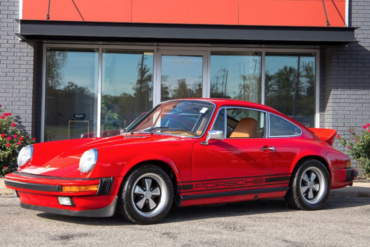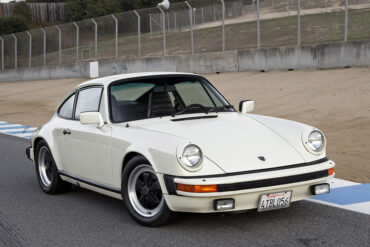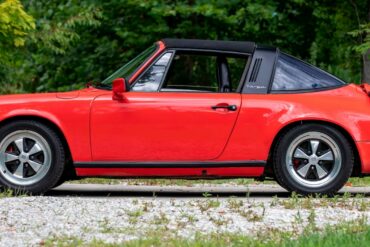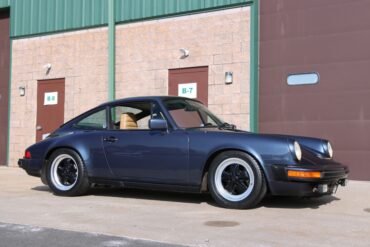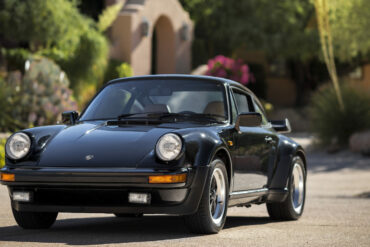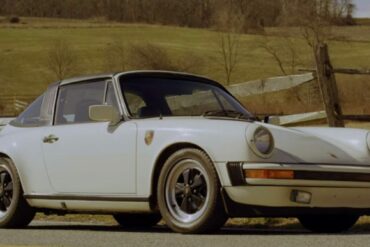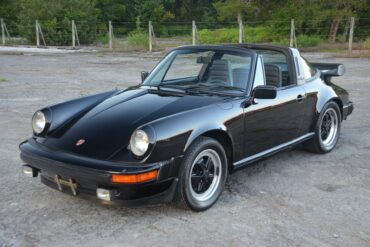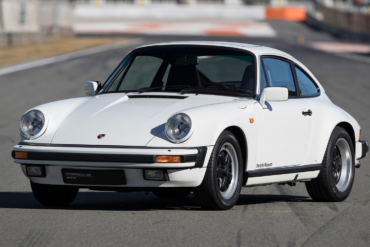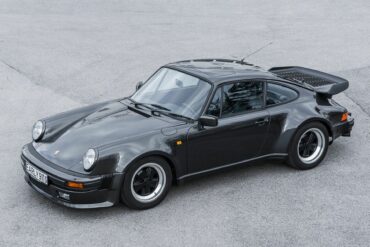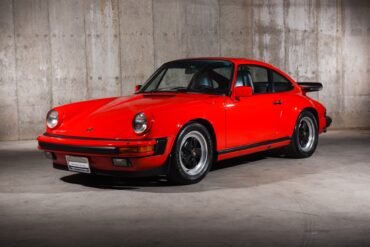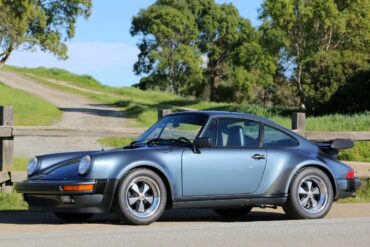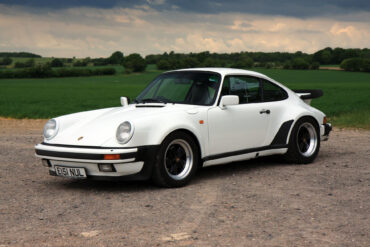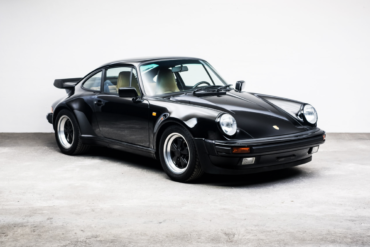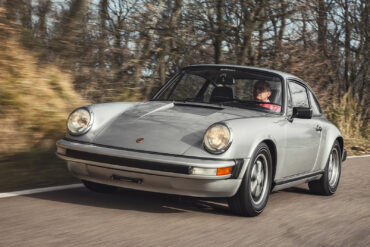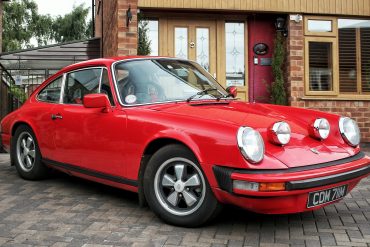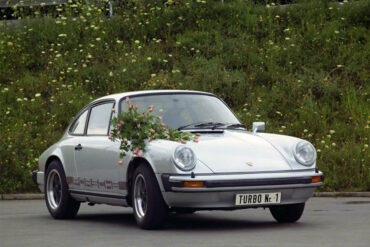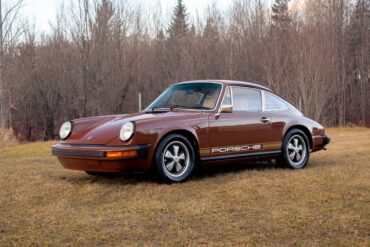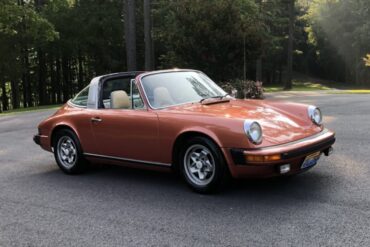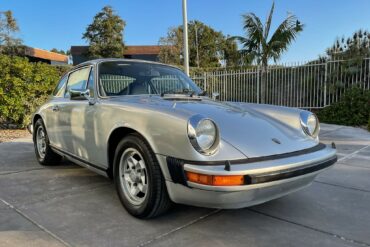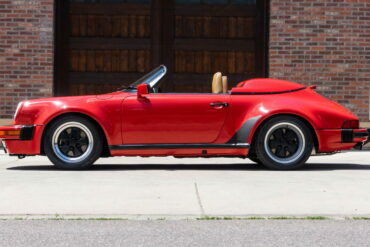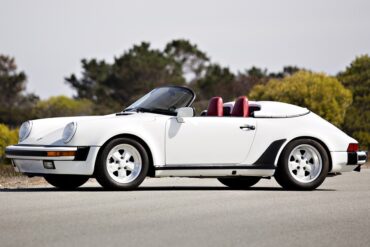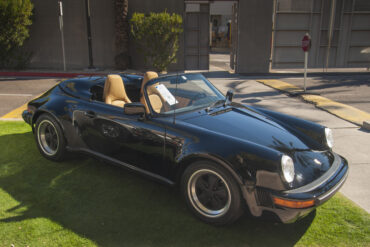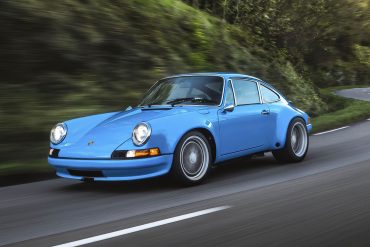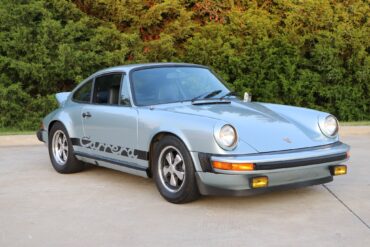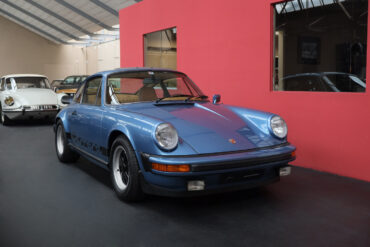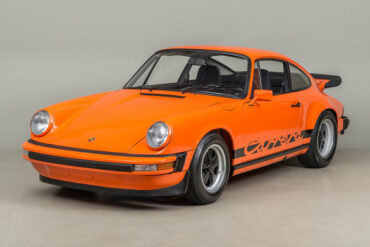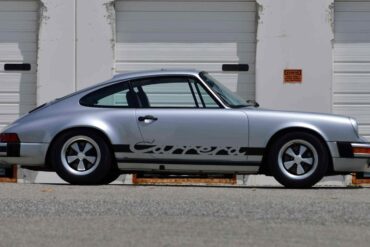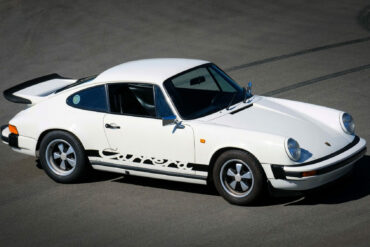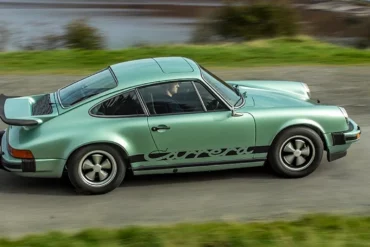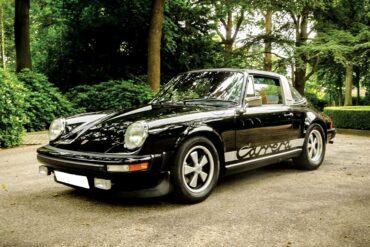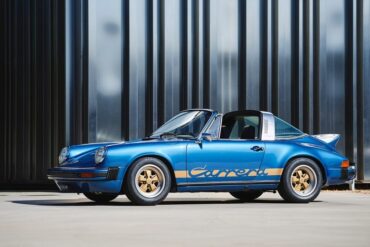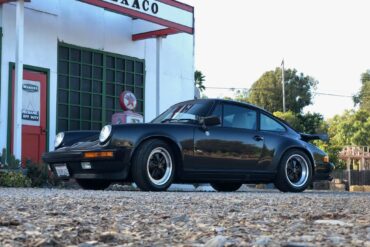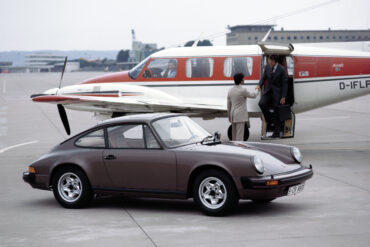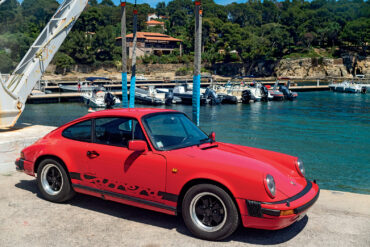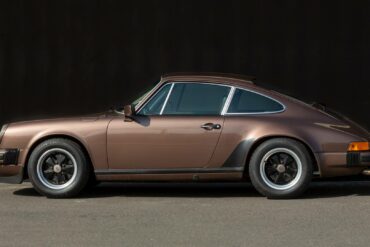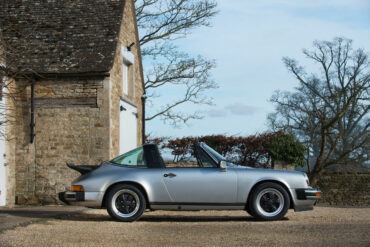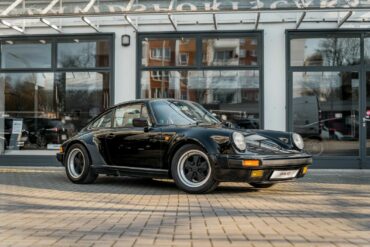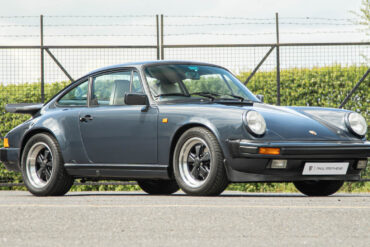Bid to get the chance to acquire a 1987 Porsche 911 Turbo Coupe at auction with Bring a Trailer! With...
Porsche 911 (G-Series)
The Porsche 911 G model was a true perennial and was built for a full 17 years. During this time, engines were built with 2.7, 3.0 and 3.2 liters. The narrow G-model (from 1974 to 1977) over the 911 SC, the Carrera 3.0 to the Carrera 3.2 gave it a large variety of variants, colors and equipment. The G-Body saw the introduction of impact bumpers to conform with low speed protection requirements of U.S. law, these bumpers being so successfully integrated into the design that they remained unchanged for 15 years. In 1974 the engine size was increased to 2,687 cc, giving an increase in torque. The use of K-Jetronic CIS Bosch fuel injection in two of the three models in the line up – the 911 and 911S models, retaining the narrow rear wings of the old 2.4, now had a detuned version of the RS engine producing 150 and 175 bhp (110 and 129 kW) respectively. See all of our G-Body (2nd Gen 911) Research.
All
- 911 (G-Series)
- 911 Carrera 3.0 (G-Series)
- 911 S (G-Series)
- 911 SC (G-Series)
- 911 Carrera 3.2 (G-Series)
- 911 Turbo (930)
- 911 SC Safari
- 911 Carrera RSR Turbo 2.1
- 911 Carrera RSR 3.0
- 911 SC San Remo
- 911 Carrera 3.2 Clubsport
- Porsche 953
- 911 Carrera RS 3.0
- 911 SC RS
- 911 Carrera 25th Anniversary
- 911 Turbo LE
- 911 3.2 Speedster
- 911 Carrera Commemorative
- 911 Carrera 2.7 (G-Series)
- 911 Turbo 2.7
Background In the early 1970s, a new European Grand Touring Championship gave the competition 911s a fresh lease of life....
We recently stumbled on a great article by Robb Report on a father and son team that builds and sells...
The turbocharged 930 was produced from early 1975 was Porsche’s flagship 911 and arguably the most capable supercar of its...
History Long regarded as the best entry-level air-cooled 911, the Carrera 3.2 remains highly desirable. It was the final evolution...
When Porsche wanted to build a 911 2.7 RS for the 1980’s, it came up with the Carrera 3.2 Club...
In 1988, Porsche unveiled the “Commemorative Edition” Carrera (also called the Jubilee Edition) to celebration the 250,000th 911. Porsche built...
Saturday, January 14th, 2023, Mecum Auctions will be offering a 1988 PORSCHE 930 TURBO with the iconic slant nose option....
With its eye-catching double-humped fiberglass tonneau cover and lowered windshield, the Porsche 911 Speedster produced only in the one-1989 is...
If you think post-war sports cars or muscle cars from the late 1960s are the staple of the collector car...
The 15th Targa California rally recently concluded with most drivers logging 1,000+ miles over the roads “less traveled” of California’s...
Evolution, not Revolution Since its debut in 1964, the Porsche 911 has epitomized engineering evolution. Conceived by Ferdinand “Butzi” Porsche,...
Originally built by German tuner Gemballa, the Avalanche was more than just a cosmetic upgrade. Boasting a powerful single-turbo engine...
“To hell with the timing. This is more important,” Wilfried Reinhardt says to himself. He hesitates for just a moment,...
Porsche 911 Carrera 3.2 Clubsport (1985) in the Museum workshop As I’ve explained on the few occasions I’ve burst into...
There are only a few annual auctions that have built the reputation of having prestigious and quality lot as Bonhams,...
Is going backward the way forward? The Porsche 911; I can’t think of another sports car that better represents an...
Our friends from PCarMarket is currently offering this 1985 Porsche 930 Turbo Slant Nose “Special Wishes” for sale with approximately...
Even before the 2022 Pikes Peak Hill Climb, it has already been reported that David Donner will attempt to beat...
In the world of automotive enthusiasts, the fusion of history, engineering, and art often leads to extraordinary creations. One such...
The Carrera RSR 3.0 stands as a rare gem among Porsches, renowned as one of the most triumphant Group 4...
The Carrera RSR 3.0 is one of those rare and super-special Porsches, and one of the most successful Group 4...
After producing no convertibles for 18 years, Porsche launched the 911 SC Cabrio in the spring 1983. The top made extensive...
Wipe the Drool From Your Chin It’s not every day that a European spec 1978 Porsche 911 SC comes your...
Each year, Porsche enthusiasts from across Norway gather in the picturesque village of Lærdal to celebrate air-cooled Porsche history. Surrounded...
This 1975 Porsche 911S Coupe underwent an extensive restoration project. The car’s bodywork was chemically stripped and sandblasted, and various...
Bring A Trailer is currently offering a 1977 Porsche 911S coupe that has been modified in RSR style from its...
The 930 was the most capable supercar of its time and catapulted Porsche’s brand worldwide, keeping up with the likes...
For decades, Porsche has been renowned for its focus on performance in the automotive industry. One of its top models,...
If you head over to Bring A Trailer now, you’ll have the chance to acquire one of the reported 33...
Live now on Mecum Auctions is perhaps one of the most popular Porsches of the 1980s, a beautiful 1987 Porsche...
One of Porsche’s most iconic cars ever was the 356 Speedster. The uniquely designed Speedster first came to life in...
This 1984 Porsche 911 Carrera coupe was backdated with a twin-plug 3.4L flat-six around 2015 and painted in silver with...
Don’t miss your chance to own a beautiful and highly original example of a 1989 Porsche 911 Speedster on Bring...
This 1979 Porsche 911SC has received some modifications, such as adding IROC/RS body styling, an upgraded suspension, custom interior, gold...
For 1989, Porsche produced the 25th Anniversary Special Edition model to mark the 25th year of 911 production. The 1989...
Collecting Cars is proud to offer a striking example of a 1978 Porsche 911 3.0 SC featuring an all-black colour...
The Porsche 911 Carrera Speedster launched in 1989 as a one-year special. It had a frameless, raked windshield that was...
Having spent its early days as a test and development hack, this 911 Carrera RSR rose to the occasion when pressed into...
If the current 911 restomods are not to your liking, you might be interested with the SUB1000 from Sportec. It’s...
In the beginning… The engine of the Porsche 911 has come a long way over the past 60 years, now...
British automotive engineering specialist, Lanzante, will once again deliver a stellar line-up for the Goodwood Festival of Speed. No less...
Background In the Porsche world, “Luftgekühlt” represents all the air-cooled cars in the manufacturer’s history, from the Pre-A 356 through...
Going Global Luftgekühlt – the hit Californian-born gathering of air-cooled Porsches – lay down new roots in Europe in mid-June,...
When Magnus Walker was invited to Fjord Lift event in Norway he quickly took the chance to drive a remarkable...
The Rinspeed Porsche R69 Turbo, aka Porsche Testarossa, was a limited production car from Switzerland. It is believed that around...
In Magnus Walker’s newest video, he gets to drive a 1982 930 Slantnose Turbo by DP Motorsport formerly owned infamous...
In the distinguished circles of Porsche enthusiasts, Magnus Walker’s 1977 Porsche 930 Turbo Carrera holds an esteemed position. This automotive...
Magnus Walker showcases a 1986 Porsche 911 modified to resemble a vintage 1970s sports car with almost 350,000 miles on...
A True Head Turner We included a car from Makellos Classics in a list of our favorite Porsche custom cars...
If you were lucky enough to visit Rennsport Reunion 7 in Monterey, California, then chances are you gazed at one...
This AutoTopNL video on YouTube showcases the incredible speed and sound of a unique Porsche 911 restomod built by CSF...
Porsche Option Codes – Pre 1970 (356, 550, 904, 911, 912) Looking to decode your pre-1970 Porsche option codes? Want...
1965 – 1989 Porsche VIN Numbers Porsche used a variety of chassis and VIN numbering systems until 1981, when a...
Porsche 911 (G, H, I & J) Technical Specifications & Model Comparison (European Variants) Comparison: European specs 911 MY1974-1977 Comparison:...
Porsche 911 (G-Series) (1973 – 1989) Story & History G-Model – The 2nd Generation Porsche 911 Premiere: September 12, 1973...
Porsche 911 (G-Body) Sales & Production Numbers (1974 – 1989) ...
Porsche 911 (G-Series) Transmission Codes The transmission number code is found on the transmission data plate. Transmission codes 911/912 G-model...
Porsche Option Codes – Porsche 911 (1974 Model Year) Looking to decode your 1974 Porsche 911 option codes? Want to...
Porsche Option Codes – Porsche 911 (1975 Model Year) Looking to decode your 1975 Porsche 911 option codes? Want to...
Porsche Option Codes – Porsche 911 (1976 Model Year) Looking to decode your 1976 Porsche 911 option codes? Want to...
Porsche Option Codes – Porsche 911 (1977 Model Year) Looking to decode your 1977 Porsche 911 option codes? Want to...
Porsche Option Codes – Porsche 911 (1978 Model Year) Looking to decode your 1978 Porsche 911 option codes? Want to...
Porsche Option Codes – Porsche 911 (1979 Model Year) Looking to decode your 1979 Porsche 911 option codes? Want to...
Porsche Option Codes – Porsche 911 (1980 Model Year) Looking to decode your 1980 Porsche 911 option codes? Want to...
Porsche Option Codes – Porsche 911 (1981 Model Year) Looking to decode your 1981 Porsche 911 option codes? Want to...
Porsche Option Codes – Porsche 911 (1982 Model Year) Looking to decode your 1982 Porsche 911 option codes? Want to...
Porsche Option Codes – Porsche 911 (1983 Model Year) Looking to decode your 1983 Porsche 911 option codes? Want to...
Porsche Option Codes – Porsche 911 (1984 Model Year) Looking to decode your 1984 Porsche 911 option codes? Want to...
Porsche Option Codes – Porsche 911 (1985 Model Year) Looking to decode your 1985 Porsche 911 option codes? Want to...
Porsche Option Codes – Porsche 911 (1986 Model Year) Looking to decode your 1986 Porsche 911 option codes? Want to...
Porsche Option Codes – Porsche 911 (1987 Model Year) Looking to decode your 1987 Porsche 911 option codes? Want to...
Porsche Option Codes – Porsche 911 (1988 Model Year) Looking to decode your 1988 Porsche 911 option codes? Want to...
Porsche Option Codes – Porsche 911 (1989 Model Year) Looking to decode your 1989 Porsche 911 option codes? Want to...
The base model Porsche 911, along with the 2.7 Liter 911S and Carrera 2.7, was introduced for the 1974 model year with many significant changes to meet legislative requirements around the world for both impact safety and emissions. It was available in Coupe and Targa variants, sporting engine Type 911/92 with K-Jetronic fuel injection, rated at 150 hp. For the 1975, the base model was discontinued in North America. ROW got Coupe and Targa variants, featuring engine Type 911/41 rated at 150 hp.
1974 – 1977 Porsche 911 2.7 Technical Specifications Body Type 2+2 seater fixed-head coupé Number Of Doors 2 Dimensions &...
The first road-going 911 Turbo was not the familiar 930 that entered production in February 1975. Nor was it the engine-less prototype that had appeared at the Paris Motor Show in October 1973. Instead, it was a one-off narrow-bodied mule that was subsequently gifted to Ferry Porsche’s sister, Louise, on her 70th birthday in August 1974. Built on chassis 9115600042, this 2.7 Carrera Turbo also pre-dated the prototype 930 that was shown in almost production-ready at Frankfurt show in 1974.
1974 – 1977 Porsche 911 2.7 Coupe Pictures & Gallery...
1974 – 1977 Porsche 911 2.7 Targa Pictures & Gallery...
Commemorating 25 years of Porsche sports car production, the 911S Silver Anniversary Edition is distinguished by unique Diamond Silver Metallic paint and a special black leatherette and tweed interior. The first of Porsche’s commemorative ‘celebration’ cars, this Silver Anniversary was produced in a limited run of 1,063 examples, of which approximately 500 are reported to have made their way to the United States.
Essentially a Carrera 3.2 with a chopped, more steeply raked windscreen and hood, plus a stripped-out interior. Most had wide Turbo bodies. Porsche insisted that the simple hood was not designed to be 100 per cent watertight. The first Porsche 911 Speedster was built in 1989 and it was the last vehicle with the old 911 body. Three decades passed before the Speedster made a comeback. Had a 3.2 L Aircooled Flat 6 and 2274 were produced for the 1989 model year.
1989 Porsche 911 Speedster Pictures & Gallery...
1989 Porsche 911 3.2 Speedster (911) Technical Specifications Price $ USD $65,480 Engine Air-cooled Flat-6 Valvetrain SOHC Displacement 3164 cc...
In a world of horsepower ratings, Nürburgring lap times, and numerous statistics that often don’t tell the complete story, it’s...
In 1974, Porsche's performance version of the 911 was simply known as the 911 Carrera. It had new bumpers that complied to American regulations and the 2.7-liter engine from the Carrera RS 2.7. Other new features for 1974 included new seats, a full-width rear taillight. The Carrera deleted all the chrome off the car in favor of black window frames, wipers, doorhandles, but chrome could be ordered as an option. In 1976 Porsche replaced the Carrera with a new 3.0 liter variant.
1974 – 1975 Porsche 911 Carrera Technical Specifications Production Years 1974 – 1975 Built At Stuttgart, Germany Price $ $13,575...
1974 – 1976 Porsche 911 Carrera MFI Technical Specifications Production Years 1974 – 1976 Built At Stutgart, Germany Production 1647...
1974 – 1975 Porsche 911 Carrera Coupe Pictures & Gallery...
1974 – 1976 Porsche 911 Carrera Coupe (MFI) Pictures & Gallery...
In 1974 Porsche offered a high performance fuel injected Carrera specifically for the European market. These were close to 2.7 RS specification and are often referred to as the 2.7 or Euro Carrera. In many regards, this car is similar to the 1973 2.7 RS in touring trim, with its 210bhp 911/83 engine, but the 2.7 Carrera is based on the updated G-series body and interior. Later Carreras that reach American shores used had reduced power and throttle response compared to Euro counterparts.
1974 – 1975 Porsche 911 Carrera 2.7 Targa Pictures & Gallery...
1974 – 1976 Porsche 911 Carrera 2.7 (MFI) Targa Pictures & Gallery...
For 1989, Porsche produced the 25th Anniversary Special Edition model to mark the 25th year of 911 production. The 1989 Porsche brochure lists production of 500 U.S. market cars, of which 300 were coupés (240 in silver metallic paint and 60 in satin black metallic), and 200 cabriolet models (160 in silver and 40 in black). All had "silk grey" leather with black accent piping and silk grey velour carpeting. Includes small bronze "25th Anniversary Special Edition" badges.
As a successor to the Carrera 2.7 MFI, the Carrera 3.0 was fitted with a variation of the 930's engine without a Turbo. During its production period only 3,687 cars were made. The Carrera 3.0 was replaced by the Porsche 911 SC for model year 1978. Between 1976 and 1977, Porsche introduced the Carrera 3.0 with wide rear flares, optional whale-tail, and other luxury options. Built before the ‘911 SC’ it has everything the SC has, and more. It’s a different drive with more power @200bhp; more torque @188 ft/lb @4200rpm and it was 10% lighter too.
1976 – 1977 Porsche 911 Carrera 3.0 Technical Specifications Type 2+2 FHC Number of doors 2 Engine 3.0 L Aircooled...
1976-1977 Porsche 911 Carrera 3.0 Coupe Pictures & Gallery ...
1976-1977 Porsche 911 Carrera 3.0 Targa Pictures & Gallery...
Porsche introduced a new wide-body package option. Known as the M491 option it was commonly known as the "Turbo-Look". It gave the naturally aspirated cars the look and style of the 930 Turbo with wide wheel arches and the distinctive "tea tray" tail. It wasn't just about looks however, because M491 also got you the stiffer suspension shared with the Turbo and the superior Turbo braking system as well as the wider Turbo wheels. It was available on the Coupe, Cab and Targa.
The replacement for the SC series came in 1984 as the 911 3.2 Carrera, reviving the Carrera name for the first time since 1977. This was the last iteration in the original 911 series, with all subsequent models featuring new body styling and new brake, electronic, and suspension technologies. Almost the same galvanised body as the SC. Engine was claimed to be 80 per cent new, and the first production 911 to feature an ECU to control the ignition and fuel systems.


